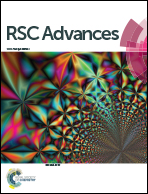Enhanced magneto-capacitance response in BaTiO3–ferrite composite systems
Abstract
This research work focuses on the enhanced magneto-capacitance response in the composites of (1 − X)BaTiO3 : X(CoFe2O4/ZnFe2O4/Co0.5Zn0.5Fe2O4) (where X = 20, 30 and 40 wt%), prepared via a conventional solid-state mixing route using auto-combustion derived powders. A new observation is the existence of two different types of morphologies such as plate-like (size was ∼5 μm with a thickness ∼1 μm) and fine agglomerated nearly spherical shape of tetragonal BaTiO3 along with the polyhedral morphology (size of ∼0.5 to ∼2.5 μm) of cubic ferrites in the prepared composite systems. Unidirectional or random orientation of the plate-like morphology of BaTiO3 in these composite systems depends on the percentage of ferrite phase. In addition to the morphology effect, the magnetoresistance effect was analyzed using magneto-impedance study as a function of frequency as well as by Cole–Cole plots. The magnetoresistance effect was found to be dependent on the type and percentage of ferrites. The combined effects of phase morphology along with magnetoresistance and/or magnetostriction led to enhanced magneto-capacitance response in these composites. The percentage of magnetocapacitance values were found to be in the range between −3 to −9, −0.5 to −7 and +1.5 to −1.5 for BaTiO3 : CoFe2O4, BaTiO3 : ZnFe2O4 and BaTiO3 : Co0.5Zn0.5Fe2O4 composites, respectively, depending on the percentage of ferrite phase.


 Please wait while we load your content...
Please wait while we load your content...